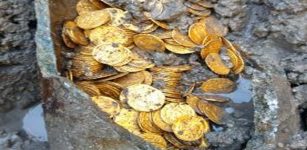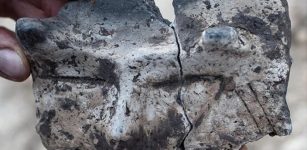Why Did Vikings Hide A Precious Silver Treasure Under The Thralls’ House?
Conny Waters - AncientPages.com - Over 1,000 years ago, Vikings chose to bury and conceal a valuable silver treasure, which has now been discovered by a farmer preparing a new tractor road on a mountain slope in southern Norway. This raises the question: why was the treasure hidden beneath what appears to have been the house of thralls?
During the Viking era, slaves—often called “thralls”—were typically prisoners of war, individuals in debt, or descendants of slaves. The Vikings captured these slaves during their infamous raids across Europe, the British Isles, and even as far as North Africa and the Middle East.
Credit: Adobe Stock - Deivison
While excavating at a Viking farm in Årdal in Hjelmeland, archaeologists uncovered numerous intriguing artifacts. Beneath the thralls' house and around 20 centimeters below the surface, they found four large silver arm rings, each uniquely decorated.
“The excavation now reveals that this was once a large and powerful Viking farm,” Demuth stated in a press release from the University of Stavanger. The Viking farm included several buildings for both people and animals. Archaeologists also discovered remnants such as soapstone pots, rivets, knife blades, and whetstones for sharpening tools.
“I initially thought we were dealing with twisted copper wires, which are often found in agricultural land,” field archaeologist Ola Tengesdal Lygre says in the press release.
“But when I saw that there were several and that they weren’t copper, but silver, I realized we had stumbled upon something significant,” he says.
Volker Demuth highlights how rare this find is, as it is uncommon for archaeologists to discover such artefacts exactly where the Vikings originally placed them.
"Since the silver treasure is located exactly where the Vikings buried it in the 9th century, it can give us completely new insights into life and society in the Viking Age," says archaeologist and project manager Volker Demuth. Credit: Volker Demuth, Archaeological Museum, University of Stavanger
“Usually, valuable objects like these are found in plowed fields, where they’re displaced from their original context. Since this silver treasure hasn’t been moved, it offers us fresh insights into life and society during the Viking Age,” he says.
Were The Vikings Forced To Flee To The Mountains?
According to Science in Norway, "the Viking farm’s strategic location allowed it to have complete control over the entrance to the fjord.
The excavation also shows that the farm was burned down at some point. The Viking Age in Norway lasted from 800 to 1050. The farm and silver treasure likely date to the 900s, a marked by considerable unrest."
Demuth considers the possibility the residents of this farm had to flee from an attack. If this were the case, it would make sense for them to hide their valuables before escaping into the mountains.
At this time, there were no silver mines in Norway, indicating that the silver must have been sourced from abroad. Vikings acquired silver through trade, received it as gifts, or seized it during raids. The newly discovered arm rings resemble the silver neck rings unearthed in the region in 1769. Archaeologists have not dismissed a potential link between these two discoveries.
Following this significant find, excavation efforts at the over 1,000-year-old Viking farm are ongoing. According to Museum Director Ole Madsen of the University of Stavanger’s Museum of Archaeology, the silver treasure will be exhibited as soon as possible.
Conservator Hege Ingjerd Hollund and archaeologist Volker Demuth are carefully unearthing a Viking treasure from a clump of soil inside the museum in Stavanger. Photo: Anniken Celine Berger
“This is an extraordinary find that provides us with unique insight into one of the most significant periods in Norwegian history: the Viking Age,” he says.
When archaeologists discover gold treasures in Norway, they typically date back to the Migration Period, 400-570. In contrast, gold treasures from the Viking Age are less common; instead, silver artifacts are more frequently found. During this era, silver largely supplanted gold's previous prominence.
See also: More Archaeology News
Viking Age silver jewelry was often fashioned from melted-down coins, many originating from Arabic regions. Rogaland stands out as the Norwegian region with the highest number of Viking Age silver finds, suggesting significant interactions between Vikings from this area and distant parts of the world.
Interestingly, numerous discoveries have been made in more remote inland regions. This raises intriguing questions about Viking trade routes and their broader interactions with other cultures.
Written by Conny Waters - AncientPages.com Staff Writer























